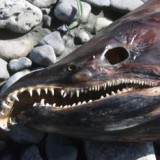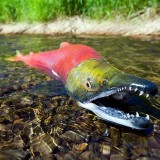The mystery of the disappearing wild salmon may be closer to being solved due to the reconvened Cohen Commission and the extraordinary three days of hearings held in December, 2011. As earlier testimony revealed, many environmental factors affect the survival of wild salmon but imported diseases from the aquaculture industry may be the largest single cause of their decline. A plausible scenario now explains how these diseases could have arrived in our West Coast ecology.
Evidence now confirms that government policy supports the salmon farming industry, and that the industry has been willing to exploit this advantage to win regulatory concessions for its economic gain – in the words of one Department of Fisheries and Oceans (DFO) official, the industry seemed “to dictate” policy. These concessions included relaxed importation, inspection and quarantine of Atlantic salmon eggs, and inadequate supervision of fish health.
Summary statements written by Gregory McDade and Lisa Glowaki, two of the lawyers representing Alexandra Morton at the inquiry, describe how DFO failed to pursue evidence indicating that ISAv was in wild salmon, despite an independent 2004 test that suggested all Cultus Lake sockeye were infected. “Instead it buried the results completely for seven years,” notes the summary, and “decided to not test any further wild salmon. This reaction is not consistent with the scientific method or a precautionary approach – rather it shows action of a political nature – denial and suppression of an inconvenient fact. In legal terms, it is known as willful blindness, also characterized in some circumstances as gross negligence.” This opinion is reinforced by DFO’s failure to submit any ISAv documentation to the Commission.
McDade and Glowaki suggest that the Canadian Food Inspection Agency (CFIA) was also implicated in this scheme of “willful blindness”. It had no interest in the well-being of wild salmon per se; its mandate was to monitor diseases and promote the economic value of food products. Fish diseases were inconveniences that complicated this commercial objective. ISAv was a reportable infection that would have alerted trade partners and the international community to risk, thereby incurring trade damage. “Safe trade” is the subject of testimony given by Dr. Kim Klotins, a senior CFIA official, to Krista Robertson, a lawyer acting for First Nations:
Robertson: “But is it also part of the mandate of the CFIA to ensure that… trade interests of Canadian companies or companies operating in Canada such as Norwegian fish farm companies, are not harmed by any kind of finding or allegation of disease?”
Dr. Klotins: “So if, let’s say, we do find ISA in B.C. and all of a sudden markets are closed, our role [CFIA] is then to try to renegotiate or negotiate market access to those countries. Now what it will be is a matter of they’ll let us know what the requirements are. We’ll let them know what we can do and whether we can meet that market access. If we can’t meet it, then there will be no trade basically.”
In other words, the discovery of ISAv in BC wild or farmed salmon could be an economic disaster that could even end trade in fish products. The CFIA didn’t want to find ISAv, and the evidence suggests it took active measures to confiscate fish samples that indicated ISAv was here. DFO – which supported the salmon farming industry – didn’t want to find ISAv either, and took active measures to hide findings and suppress research that would have exposed it. And the salmon farming industry certainly didn’t want to discover ISAv in its brood stock or net-pens – such a discovery would have had devastating environmental, market and public relations ramifications.
So, why did salmon farmers not find ISAv in their testing of more than 4,700 samples of farmed fish? The sole veterinarian testing their fish was Dr. Gary Marty, who noted more than 1,100 instances of lesions that were commensurate with ISAv, but he always recorded negative results for the viral infection. The industry, therefore, could confidently announce, as it frequently did, “that the ISA virus has never been found in British Columbia” (Times-Colonist, Dec. 16/11).
McDade and Glowaki explain this puzzle. First, not all ISAv strains are lethal so salmon farms might not notice high mortality. Like an influenza, it can exist as a low level infection that only becomes virulent when it mutates – particularly in high population densities at fish farms and hatcheries. But ISAv does impair fish health – especially wild fish in stressful survival conditions – and it leaves identifiable cellular markers. This is what the genomic specialists Drs. Kristi Miller, Fredrick Kibenge and Are Nylund found in their independent sampling of wild salmon tissue – they couldn’t find it in farmed salmon because the industry thwarted efforts to test these fish.
Was the salmon farming industry concealing evidence of ISAv? Not exactly. The following is the McDade and Glowaki technical explanation: “The evidence is now clear that Dr. Marty was conducting PCR tests with no confirmed validity. His PCR test was developed in-house, by a master’s student. This methodology used a primer that was different from that approved by the OIE or by the Moncton lab. It was a primer that had never been through the validation process, nor even apparently a peer-reviewed publication. Dr. Kibenge testified that in his opinion this test would not be sensitive to finding ISA.” So the “self-invented” test had no validity and “in our respectful submission, this ‘non-disclosure’ is tantamount to deliberate deception”. Since the salmon farming industry didn’t want to find ISAv, DFO had chosen to be “willfully blind” by relying only on the invalid testing of this single lab, and the CFIA was contented to avoid the complexities of discovering ISAv, no such disease was ever found by anyone responsible for detecting it.
The ISAv evidence will eventually be weighed by Judge Bruce Cohen. But the virus is now in the realm of public awareness, and the seismic effects could eventually shake the salmon farming industry, the wild fishery, and the government agencies that were supposed to be safeguarding an invaluable marine ecology.






